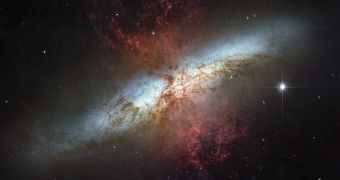A group of astronomers supported by the National Radio Astronomy Observatory (NRAO) was recently able to collect an impressive new image of the massive starburst galaxy M82. The photo was collected using the W-Band receiver, a new instrument on a large radio telescope.
The research centered on this particular starburst galaxy because it is located a mere 12 million light-years away from Earth, which is very nearby in astronomical terms. Scientists used the US National Science Foundation's (NSF) Robert C. Byrd Green Bank Telescope (GBT) for the investigations.
The W-Band receiver instrument was recently installed on the observatory, and now enables astronomers to see nearby galaxies in ways that were not possible before. With the addition of this new capability, the GBT becomes the world's largest single-dish, millimeter-wave telescope.
Its recent target, M82, is located in the direction of the constellation Ursa Major, e! Science News reports. The reason why it appears so brightly in the new datasets is that it features a massive amount of molecular hydrogen gas, which can release radiations in millimeter wavelengths when irradiated.
The reason why M82 is classified as a starburst galaxy is that it contains a large number of stellar nurseries, locations in space where hydrogen clouds lead to the formation of new, blue stars. The galaxy is producing new celestial fireballs at a much faster rate than the Milky Way.
In addition to stellar nurseries, the GBT was also able to discover streamers of material flowing out from the disk of the galaxy. These structures puzzle astrophysicists somewhat, and will probably make for an interesting study later on.
“With this new vision, we were able to look at M82 to explore how the distribution of molecular gas in the galaxy corresponded to areas of intense star formation. Having this new capability may help us understand why stars form where they do,” says researcher Amanda Kepley.
She holds an appointment as a post-doctoral fellow at the NRAO, in Green Bank, West Virginia, and was also the lead author of a new paper detailing the findings, which will be published in an upcoming issue of the esteemed Astrophysical Journal Letters.
“The GBT data clearly show billowing concentrations of dense molecular gas huddled around areas that are undergoing bursts of intense star formation. They also reveal giant outflows of ionized gas fleeing the disk of the galaxy. These outflows are driven by star formation deep within the galaxy,” the researcher concludes.

 14 DAY TRIAL //
14 DAY TRIAL //